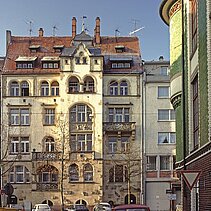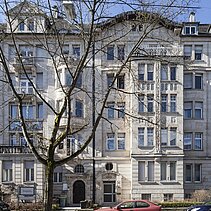Bleichstraße Before 1945
Places and Buildings Before 1945
[1] around 1925
Bleichstraße, going out from Sedanplatz, was made accessible with cross streets in Wilhelminian time for the municipal construction. Some metropolitan residence- and jewelry factory-buildings as Kollmar & Jourdan and Rodi & Wienenberger were created. Since 1911, the municipal tram went through Bleichstraße.
[2] around 1925
The Bleichstraße is called after the historic "bleach". In former times, the low meadows served as laundry bleach south of town between Nagold, Metzelgraben and Bleichstraße. The need of the textile industry for bleaching- and coloring-means led in 1804 to foundation of a "Salmiakhütte" at the outer Bleichstraße which was acquired in 1823 by Johann A. Benckiser and extended to a chemical factory, a predecessor of todays globally operating enterprise Reckitt Benckiser GmbH.
[3] 1922
The corner building Bleichstraße 77 was built in 1922 as "Kontorhaus" for the jewelry- and watch chain-factory Kollmar & Jourdan according to plans of the architecture office Hermann Walder in Karlsruhe. An arch bridge forms the direct connection to the factory complex. Five breast figures, decorated with jewels, represent at the façade the five earth parts, an allegory of the global business connections of the company.
[4] around 1910
Between 1901 and 1910, the jewelry- and watch chain-factory Kollmar & Jourdan was established following plans of Hermann Walder from Karlsruhe. This representative four-wing factory building along Bleich-, Hans-Meid-, Kallhardt- and Schießhausstraße was established as steel skeleton construction and covered on the outside with color-glazed bricks. The enterprise, founded in 1885, was temporarily the biggest chain factory of the world with more than 1.000 employees.
Bleichstraße After 1945
Places and Buildings After 1945
[1] 2017
The jewelry- and watch chain-enterprise Kollmar & Jourdan was liquidated in 1977 and became business house. In the north wing, todays Technical Museum of the Jewelry- and Watch Industry of Pforzheim is set up newly redesigned in 2017. In the upper storeys of this former factory "Pforzheim Galerie" and "Carlo Schmid Schule" are located.
[2] 2017
The building "Bleichstraße 88" was established in 1905 as headquarters of the tradition-rich manufactury Victor Mayer. This enterprise, founded in 1890, has been internationally successful amongst others with Jugendstil-jewelry. Up to now, the enterprise produces high-quality jewelry. The architect Heinrich Deichsel from Pforzheim supplied the design for this lavishly decorated Jugendstil-building that takes up shapes of the Middle Age.
[3] 2017
The both residence-factory houses Bleichstraße 92/94 were designed in 1905-07 by the architects Karl Faller and Theodor Preckel from Pforzheim for the factory owner Theodor Denzle. Behind the decorating Jugendstil-façades, there hide modern concrete skeleton constructions and three-storey backyard-wings for jewelry-manufacturies as they had been typical for the industry of Pforzheim around 1900.
[1] 1945
In the air attack of 23rd February 1945, the north-east wing of the building of company Kollmar & Jourdan was almost destroyed at "Hans-Meid-Straße" and "Kallhardtstraße". The re-construction of the remaining parts happened up to the year 1949 with flat roofs and stacked storeys instead of the original steep roofs, corner towers and gables.











